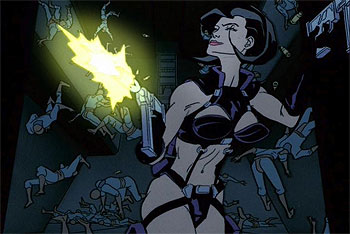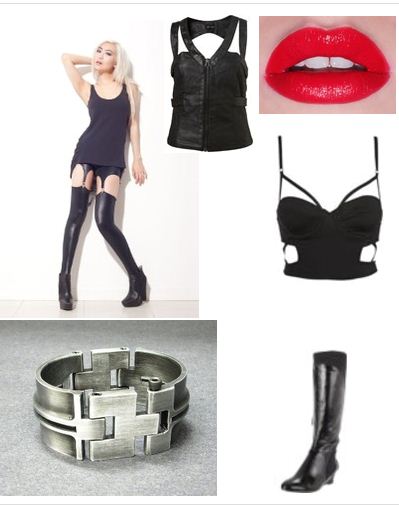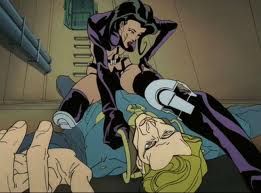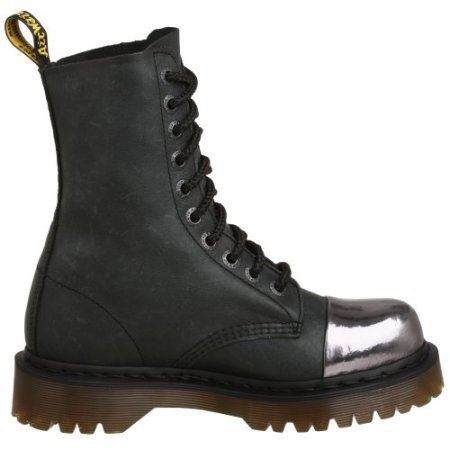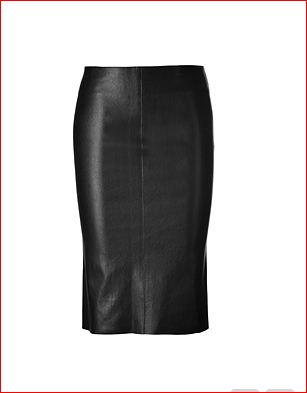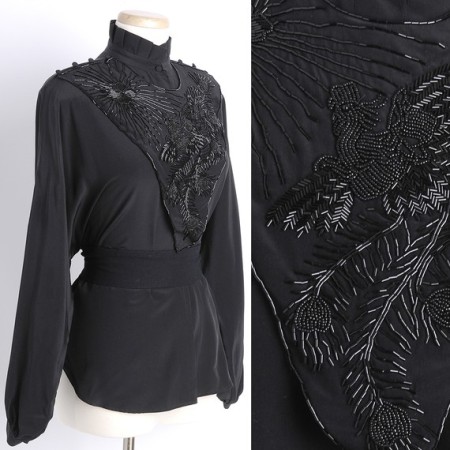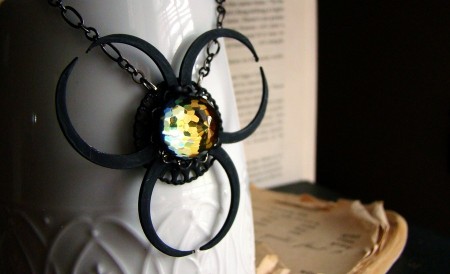A Brief History
If Malcolm McLaren hadn’t been running a bondage fashion shop, one can wonder if punks would have chosen some other apparel to shock middle-class sensibilities. The prevalence of bondage gear as punk—and later, Goth—signifiers has its roots partially in McLaren’s desire to promote his shop (then co-owned with Vivienne Westwood). But looking beyond the capitalist reasons why bondage fashion was associated with the punk movement, there are a number of symbolic meanings expressed by the choice of bondage as fashion. Westwood has been influential in shaping postmodern fashion, an aesthetic that embraces “clothing and imagery that appear dirty, ripped, scarred, shocking, spectacular, cruel, traumatized, sick, or alienating.” The youth of an economically ravaged, crumbling former empire walking the streets in collars, leashes and pants with strategically-placed straps and buckles designed for immobilization aimed for shock, spectacle and alienation. If Nationalism is Romantic (and I do think that it is) then punk used a harsh anti-Romanticism as a political and sartorial weapon. Bondage as fashion confronted several social myths. Gavin Baddeley, in the book Goth Chic, claims that “punk’s self-appointed thought police . . . associated sexual dominance games with sexism and the hated middle classes.” In laying bare the power dynamics of romantic-sexual relationships, bondage gear made visible the tension between power and romance underlying hetero relationships. Bondage fashion brought society’s dirty secrets out onto the streets. It revealed the former empire’s decadence, cruelty and hypocrisy. Wearing bondage gear was a sign that the wearer wasn’t buying in to the mainstream’s romantic narrative and their role therein.
Ironically, punk has historically been a subculture that prizes certain active virtues assumed to be masculine—freedom from authority, toughness, self-sufficiency—yet males (and females) embraced bondage fashions that in BDSM circles often denote submissiveness such as dog collars, wrist cuffs, and padlocked chains. These fashions paired with aggressive metal spikes, combat boots and hard, gravity-defying hairstyles. While punk music for the most part embraces an aggressive, anti-authoritarian and occasionally nihilistic perspective, there is a connection between submissive BDSM signals and the punk message. Portraying oneself as bound, restricted, beaten or oppressed reflected the real economic and social state of the youth in the U.K. (and to a lesser extent, the U.S.) during the 1970s. The Sex Pistols declared there was no future. X-Ray Specs more overtly mocked youths’ social position with the lines “thrash me, crash me, beat me till I fall. I wanna be a victim for you all” in “Oh Bondage up Yours.” This sentiment gets to the heart of the punk use of bondage fashion: while it demonstrated the wearer’s sense of alienation, it also confronted the passersby with their own complicity in a system that kept them in slavery to its useful social and economic fictions.
Anti-Ordinary
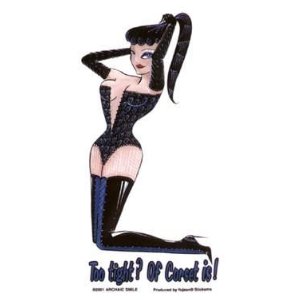
Archaic Smile Sticker
As Goth mutated away from punk it kept the latter’s resistance to the mainstream. In many ways, the practice of rejecting mainstream values shaped much of Goth’s preoccupations; from alternative spiritualities (Wicca, Neo-Paganism, Left-Hand Paths other forms of magick) to alternative sexualities. While punks also availed themselves of fetish fashions, Goth embraced these is sometimes unironic ways. As part of an expression of allegiance with everything shunned by the dominant culture, fetish and bondage fashion fit neatly into Goth’s system of valorizing the shadow side of the collective psyche. In a great post on what’s wrong with conflating the BDSM-fetish scenes and the Industrial music scene on the Industrial Anti-Oppression blog, Strigiform writes “from what I understand, industrial was not always associated with fetish, latex, women making out for men, etc. It was associated with pushing boundaries and counter cultures which I am sure at times included BDSM.” As with Goth, alignment with marginalized or underground groups and practices was sought as a rejection of the mainstream. The (at one time) difficulty of finding these items of clothing further imbued the wearer with subcultural credibility, as this formed a visible barrier to purchasing a Goth wardrobe from your local department store. However, Goth’s orientation toward more feminine values colored the use of sexualized clothing. For example, the corset—which by the late 20th century had ceased to be underwear and become fetishwear—exaggerated the natural shape of the feminine body in resistance to the dominant culture’s ideal of a very thin, athletic, less fleshy female shape. The corset suits bodies that have some adipose tissue to compress and shift, and Goths of all sizes enjoy the benefits of this severe restriction. The corset, preferably with steel boning, tightened to reduce the waist by up to four inches, also forces the wearer upright. Its weight and rigidity encompass the wearer like armor. A common refrain found on buttons, t-shirts and stickers marketed to Goths proclaims “Tight? Of CORSET is” or some variant thereof, claiming the difficulty and occasional discomfort of corsetry as a signal of subcultural pride.
A Note on Corsets
A brief digression here on the comfort, or lack thereof, of corset-wearing. Modern corsets may give that Victorian hourglass shape, but they are made quite differently and are designed to be worn primarily as outerwear, not underwear. Aside from some extreme body modifiers, the 15-inch waists Victorian medical literature warned about are not prevalent. Keep in mind that those tiny-waisted women of yore were put into corsets in childhood and constantly wore compressive garments as they grew. Think of them as having bonsai waists if it helps. A modern corset can be quite comfortable for a long evening. The lacing can be adjusted so that the wearer can take full breaths. Some people can bend and dance with no problem. I have trouble bending at the waist when I wear one, but that’s easily accommodated. There have been times that I couldn’t wait to get out of my corset; one being when I made the mistake of wearing an underwire bra underneath—remember, everything gets pushed up—another when I went for a corset fitting right after eating a broccoli omelet. Nothing bad happened, it just made my stomach hurt after 10 minutes.
The Meaning of Masochism
BDSM fashion symbolically represented the Gothic embrace of romanticized pain, masochism and the taboo, forbidden or occult (L. occultus “hidden, concealed, secret,”). This, I believe, also explains the prevalence of Catholic imagery and symbols such as crucifixes and the more bloody depictions of martyrdom; imagery of pain and suffering appeal to a perspective that seeks the sublime through darkness. Catholicism has a particularly vivid and rich tradition of encouraging the aestheticization of pain, with many examples of beautiful artwork depicting the death and suffering of saints. Bondage fashion is another way to wear reminders of pain. Gothic masochism tends to embrace pain as entwined with pleasure, at least psychologically. Piercings, tattoos and other body modifications are also visible signals of pain turned into beauty. However, masochism cannot be taken as a literal pursuit. Alongside the Gothic celebration of symbolic masochism, there are the appealing dramatized and ritualized aspects of fetish/BDSM images. The Gothic aesthetic is nothing if not dramatic, and BDSM imagery often involves ritualized violence and power as sexual psychodrama. Even though there is some overlap between Gothic and BDSM circles, it would be a mistake to assume that because a Goth is dressed in a black latex catsuit she’s indicating any interest in flogging random men who cross her path. The drama of power as expressed through fashion is the primary interest more often than not.
Here is the greatest misunderstanding outside Goth circles. Bondage and fetish fashions, though not worn with punk’s confrontational intent, are symbolic of a perspective that embraces aestheticized masochism, not necessarily literal BDSM interests. In Paul Hodkinson’ Goth: Identity, Style and Subculture, many of his interviewees mentioned being irritated by people who assumed their Gothic fetish fashions were sexual advertisements. The post from Gothic Confessions above testifies that Gothic fashion is still being misinterpreted. Even the code of conduct at NYC Goth club Absolution addresses this:
“Will you find someone at ABSOLUTION to satisfy your fetish? You could, but that is not the main topic of the night so sitting around all night waiting for someone to spank or trample you might prove frustrating. If your main goal is to satisfy a fetish, you may have better luck at a party which lists fetishism as one of its main topics.”
Gothic dating sites seem full of men who have no interest in Gothic culture, but will leeringly write at length about how they’ve heard Gothic women are “freaky” and “will do anything.” The conduct code at Absolution goes on to explain
“A word about fetishists who are “carpet men”(guys who like to lie down on the floor and get trampled): You are welcome to come in and lie down on the floor in the hope of being trampled, but you cannot lie down in front of the bar at my club. I realize this is the area where people are most likely to congregate, but that makes no difference because we need that area accessible to customers. The truth is that if you employed the services of a dominatrix to satisfy your “trampling fetish”, you’d be spending upwards of $300 or more for a single hour of her time. You are gratifying your fetish for $10 or less at my club for many hours, so you get what you pay for,” further demonstrating that Goths are often assumed to be some sort of brigade of volunteer kinky sex workers.
In my next post, I want to address how class dynamics fit into this picture, as well as covering what I’ve come to see as increased conformity to mainstream gender roles.
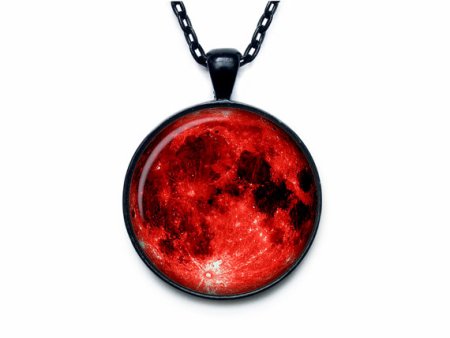 This blood moon pendant by Out of Space Jewelry reflects the image of the darkened eclipse moon. Hang this around your neck in the hopes that in seeing her reflection, the Moon will briefly take pity upon you and confine her ill effects to an easily solved and inexpensive household issue, like running out of laundry soap.
This blood moon pendant by Out of Space Jewelry reflects the image of the darkened eclipse moon. Hang this around your neck in the hopes that in seeing her reflection, the Moon will briefly take pity upon you and confine her ill effects to an easily solved and inexpensive household issue, like running out of laundry soap.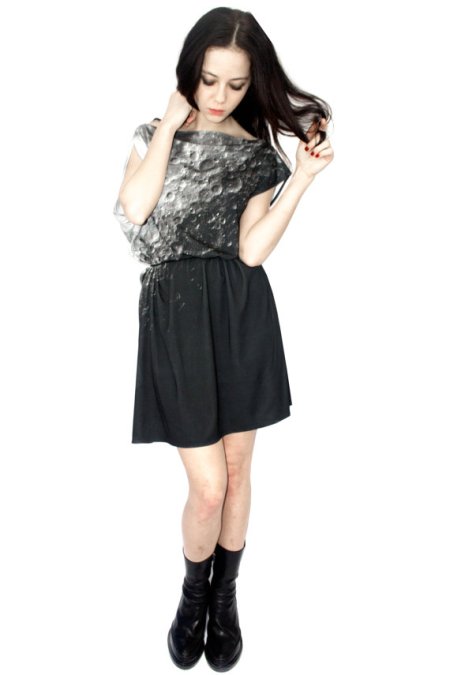 This lunar jersey dress by Shadowplay NYC reminds the universe: “I’m a Moonchild. Do not fuck with me, dark powers.” It’s made of cotton jersey, and so sensible for the upcoming heat of late spring and summer. The dress can be worn several ways, either as a short dress or a long tunic. It’s sewn so that it hangs asymmetrically. I recently got one of these dresses in a different print from Shadowplay, and it fits more like a long tunic. I love their cosmic prints. Try wearing this to your Esbats for an extra moon-boost.
This lunar jersey dress by Shadowplay NYC reminds the universe: “I’m a Moonchild. Do not fuck with me, dark powers.” It’s made of cotton jersey, and so sensible for the upcoming heat of late spring and summer. The dress can be worn several ways, either as a short dress or a long tunic. It’s sewn so that it hangs asymmetrically. I recently got one of these dresses in a different print from Shadowplay, and it fits more like a long tunic. I love their cosmic prints. Try wearing this to your Esbats for an extra moon-boost.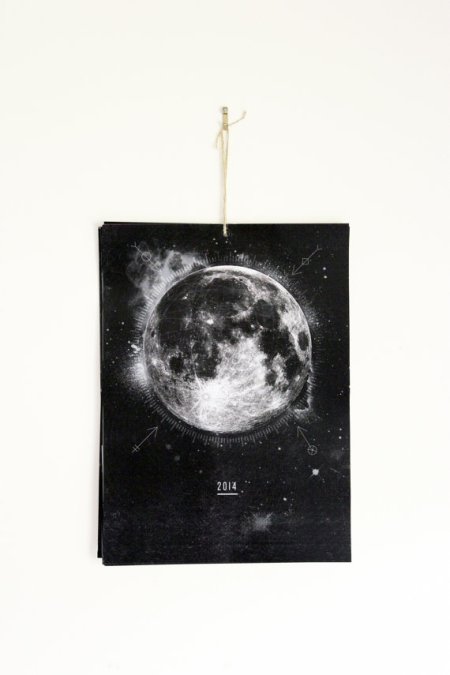 This stylish lunar calendar by Thorburn Collective will help you keep track of the moon’s phases.
This stylish lunar calendar by Thorburn Collective will help you keep track of the moon’s phases.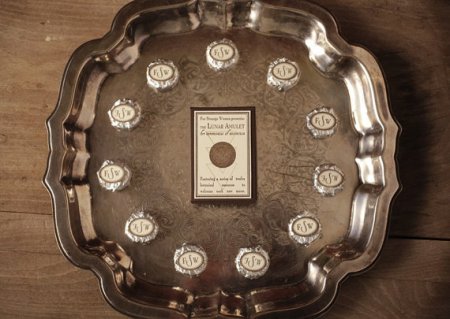 The Lunar Amulet for Ceremonies of Intention by For Strange Women is a series of perfumes attuned to each new moon of the year. This version comes in a brass locket with faceted onyx representing the dark moon. There are some really stunning perfume lockets in their shop, like this one and this one.
The Lunar Amulet for Ceremonies of Intention by For Strange Women is a series of perfumes attuned to each new moon of the year. This version comes in a brass locket with faceted onyx representing the dark moon. There are some really stunning perfume lockets in their shop, like this one and this one.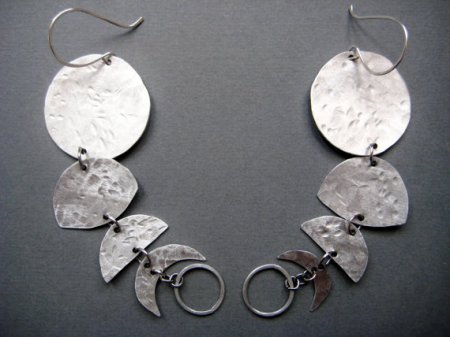 For proper lunar protection, you’ll need silver. These hammered silver moon phase earrings by Aurora Shadow should fit the bill. Moon phases seem to be A Thing right now, from shirts to nails to cellphone covers, and I’m not opposed to this.
For proper lunar protection, you’ll need silver. These hammered silver moon phase earrings by Aurora Shadow should fit the bill. Moon phases seem to be A Thing right now, from shirts to nails to cellphone covers, and I’m not opposed to this.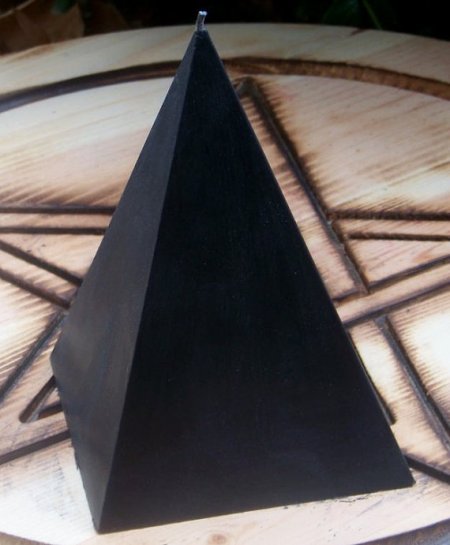 If all else fails, pull out your pyramid of power candle (by Artisan Witchcrafts) and do whatever banishing rituals you need to get your shit back together.
If all else fails, pull out your pyramid of power candle (by Artisan Witchcrafts) and do whatever banishing rituals you need to get your shit back together.





